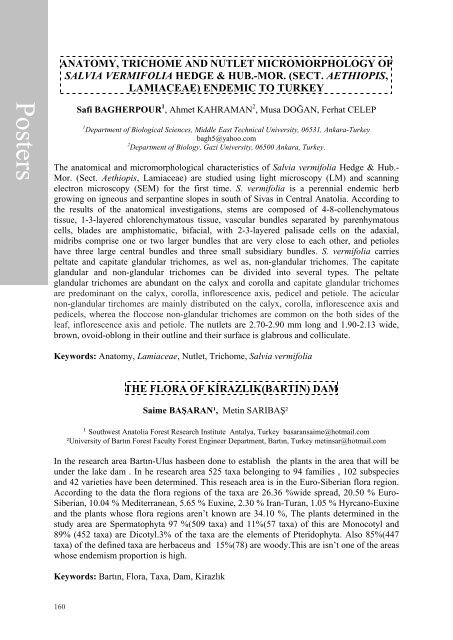Adil GÜNER, Vehbi ESER - optima
Adil GÜNER, Vehbi ESER - optima
Adil GÜNER, Vehbi ESER - optima
You also want an ePaper? Increase the reach of your titles
YUMPU automatically turns print PDFs into web optimized ePapers that Google loves.
Posters<br />
160<br />
ANATOMY, TRICHOME AND NUTLET MICROMORPHOLOGY OF<br />
SALVIA VERMIFOLIA HEDGE & HUB.-MOR. (SECT. AETHIOPIS,<br />
LAMIACEAE) ENDEMIC TO TURKEY<br />
Safi BAGHERPOUR 1 , Ahmet KAHRAMAN 2 , Musa DO�AN, Ferhat CELEP<br />
1 Department of Biological Sciences, Middle East Technical University, 06531, Ankara-Turkey<br />
bagh5@yahoo.com<br />
2 Department of Biology, Gazi University, 06500 Ankara, Turkey.<br />
The anatomical and micromorphological characteristics of Salvia vermifolia Hedge & Hub.-<br />
Mor. (Sect. Aethiopis, Lamiaceae) are studied using light microscopy (LM) and scanning<br />
electron microscopy (SEM) for the first time. S. vermifolia is a perennial endemic herb<br />
growing on igneous and serpantine slopes in south of Sivas in Central Anatolia. According to<br />
the results of the anatomical investigations, stems are composed of 4-8-collenchymatous<br />
tissue, 1-3-layered chlorenchymatous tissue, vascular bundles separated by parenhymatous<br />
cells, blades are amphistomatic, bifacial, with 2-3-layered palisade cells on the adaxial,<br />
midribs comprise one or two larger bundles that are very close to each other, and petioles<br />
have three large central bundles and three small subsidiary bundles. S. vermifolia carries<br />
peltate and capitate glandular trichomes, as wel as, non-glandular trichomes. The capitate<br />
glandular and non-glandular trichomes can be divided into several types. The peltate<br />
glandular trichomes are abundant on the calyx and corolla and capitate glandular trichomes<br />
are predominant on the calyx, corolla, inflorescence axis, pedicel and petiole. The acicular<br />
non-glandular tirchomes are mainly distributed on the calyx, corolla, inflorescence axis and<br />
pedicels, wherea the floccose non-glandular trichomes are common on the both sides of the<br />
leaf, inflorescence axis and petiole. The nutlets are 2.70-2.90 mm long and 1.90-2.13 wide,<br />
brown, ovoid-oblong in their outline and their surface is glabrous and colliculate.<br />
Keywords: Anatomy, Lamiaceae, Nutlet, Trichome, Salvia vermifolia<br />
THE FLORA OF K�RAZLIK(BARTIN) DAM<br />
Saime BA�ARAN¹, Metin SARIBA�²<br />
¹ Southwest Anatolia Forest Research Institute Antalya, Turkey basaransaime@hotmail.com<br />
²University of Bart�n Forest Faculty Forest Engineer Department, Bart�n, Turkey metinsar@hotmail.com<br />
In the research area Bart�n-Ulus hasbeen done to establish the plants in the area that will be<br />
under the lake dam . In he research area 525 taxa belonging to 94 families , 102 subspecies<br />
and 42 varieties have been determined. This reseach area is in the Euro-Siberian flora region.<br />
According to the data the flora regions of the taxa are 26.36 %wide spread, 20.50 % Euro-<br />
Siberian, 10.04 % Mediterranean, 5.65 % Euxine, 2.30 % Iran-Turan, 1.05 % Hyrcano-Euxine<br />
and the plants whose flora regions aren’t known are 34.10 %, The plants determined in the<br />
study area are Spermatophyta 97 %(509 taxa) and 11%(57 taxa) of this are Monocotyl and<br />
89% (452 taxa) are Dicotyl.3% of the taxa are the elements of Pteridophyta. Also 85%(447<br />
taxa) of the defined taxa are herbaceus and 15%(78) are woody.This are isn’t one of the areas<br />
whose endemism proportion is high.<br />
Keywords: Bart�n, Flora, Taxa, Dam, Kirazl�k<br />
96






